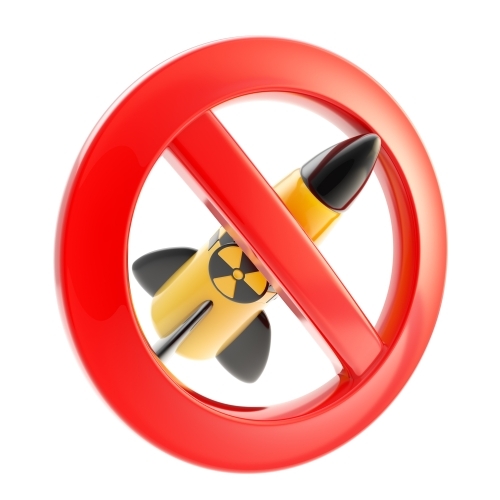Written by Beatrix Immenkamp,

In December 2009, the United Nations General Assembly unanimously declared 29 August the International Day against Nuclear Tests. This day marks both the closure, in 1991, of the former Soviet Semipalatinsk Test Site in modern-day Kazakhstan and the date of the first Soviet nuclear test conducted there in 1949.
Nuclear weapons testing began in the mid-twentieth century. The first test took place on 16 July 1945; since then, an estimated 2 000 nuclear tests have been carried out around the world. The disastrous effects of nuclear testing on human health and the environment only emerged over time and gave rise to joint efforts to prevent further nuclear weapons testing. The international instrument to put an end to all forms of nuclear testing is the 1996 Comprehensive Nuclear-Test-Ban Treaty (CTBT).
The Comprehensive Nuclear-Test-Ban Treaty (CTBT)
The CTBT is a multilateral treaty by which states agree to ban all nuclear explosions in all environments, for military or civilian purposes. It was adopted by the United Nations General Assembly on 10 September 1996, and opened for signature in New York on 24 September 1996. 20 years later, the CTBT has not yet come into force.
Of the 183 states that have become members of the CTBT, 164 states have ratified the Treaty, whereas 19 states have merely signed it. Some 13 states have not yet acceded to the Treaty at all, including, India, North Korea, and Pakistan. The CTBT has not yet entered into force, pending ratification by the remaining eight states (out of a total of 44) that possess nuclear reactors and research reactors listed in Annex 2 to the Treaty. In addition to India, North Korea, and Pakistan, these remaining states include China, Egypt, Iran, Israel and the United States of America.
Nuclear testing essentially ended with the adoption of the CTBT in 1996. The small number of nuclear tests conducted after 1996 (by India, Pakistan and most recently the Democratic People’s Republic of North Korea – DPRK) were universally condemned and led to the imposition of sanctions.
The Treaty establishes a CTBT Organisation (CTBTO), located in Vienna, to ensure the implementation of its provisions, which include international verification measures. The CTBT verification regime is designed to detect any nuclear explosion conducted on Earth – underground, underwater or in the atmosphere.
The CTBTO comprises two organs, the Provisional Technical Secretariat and the Preparatory Commission:
- Provisional Technical Secretariat (PTS): The PTS began its work in 1997 and has an international staff of approximately 270 members from 70 countries. The PTS cooperates with the host countries in the development and running of the international monitoring system.
- Preparatory Commission: The main task of the Preparatory Commission is to establish a global verification regime as foreseen in the CTBT, aiming at being operational by the time the Treaty enters into force. The International Monitoring System will comprise 321 monitoring stations and 16 laboratories, which will monitor the planet for any sign of a nuclear explosion. The international monitoring system is 85% installed, and a large number of stations are already transmitting data to the International Data Center (IDC) in Vienna via satellite-based global communications infrastructure.
The global non-proliferation and disarmament regime
The CTBT forms part of the global non-proliferation and disarmament regime built around the Nuclear Non-Proliferation Treaty (NPT), including the International Atomic Energy Agency (IAEA), five Treaties establishing Nuclear-Weapon-Free Zones, the International Convention for the Suppression of Acts of Nuclear Terrorism, UN Security Council Resolution 1540, the Convention on Nuclear Safety, the Convention on the Physical Protection of Nuclear Material, the Joint Convention on the Safety of Spent Fuel Management and on the Safety of Radioactive Waste Management and a number of informal and/or voluntary initiatives.
The EU position on the CTBT
According to the Working paper submitted by the EU to the Fifth NPT Review Conference in 2015, the EU considers the CTBT ‘to be of crucial importance to nuclear disarmament and non-proliferation. Its entry into force remains a top priority for the European Union’. The EU seeks to use every opportunity to advocate CTBT ratification in international fora and meetings with countries that have not yet signed or ratified the Treaty. The EU has also carried out CTBT outreach activities in different regions of the world. The EU’s political efforts are complemented by financial commitments to support the CTBTO, amounting to €15.5 million between 2006 and 2015, placing the EU among the most important financial contributors to the CTBTO. The Council adopted a Decision on 12 October 2015 to make an additional €3 million available to support the activities of the Preparatory Commission of the CTBTO in order to strengthen its monitoring and verification capabilities.
Debate in the European Parliament
To mark the 20th anniversary of the CTBT, Members of the Foreign Affairs Committee of the European Parliament exchanged views with Federica Mogherini, High Representative of the European Union for Foreign Affairs and Security Policy and Vice-President of the European Commission, and Lassina Zerbo, Executive Secretary of the Comprehensive Nuclear-Test-Ban Treaty Organization, on 7 July 2016. There was consensus that renewed effort is needed to ensure the entry into force of the Treaty, through ratification by the remaining Annex 2 States.
Further EPRS Publications
- Safety of nuclear installations in Belarus [Plenary Podcast], Naja Bentzen
- Iraq-Iran relations following the nuclear deal, Beatrix Immenkamp,
- Iran after the nuclear deal: Implications for the region and the EU, Patryk Pawlak and Christian Dietrich
- The nuclear agreement with Iran, Patryk Pawlak and Christian Dietrich
- Nuclear Non-Proliferation Treaty (NPT): State of play, Carmen-Cristina Cirlig
- New sanctions against North Korea: The challenges of implementation and China, Gisela Grieger








Be the first to write a comment.